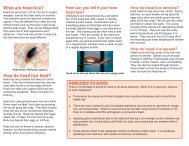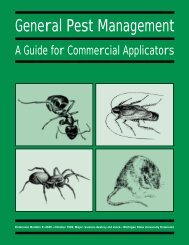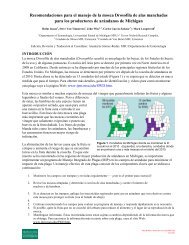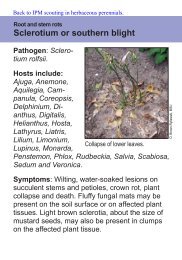Bed Bugs - Michigan State University: Integrated Pest Management
Bed Bugs - Michigan State University: Integrated Pest Management
Bed Bugs - Michigan State University: Integrated Pest Management
You also want an ePaper? Increase the reach of your titles
YUMPU automatically turns print PDFs into web optimized ePapers that Google loves.
<strong>Bed</strong> <strong>Bugs</strong>: What’s New?<br />
By Mark D. Sheperdigian, BCE<br />
Rose <strong>Pest</strong> Solutions<br />
Troy, <strong>Michigan</strong><br />
Introduction: A Brief history<br />
Once upon a time…bed bugs were common place. People had come to accept the bugs<br />
as an annoying part of life and we did what we could to mitigate the irritation.<br />
“<strong>Bed</strong> bugs are among the most common and troublesome of all household pests in human<br />
habitations.” <strong>Pest</strong> Control Technology, 1950<br />
Somewhere in the 60’s, quietly & without fanfare, they went away. We take credit, but<br />
there may be more at work than some well-placed insecticides and a few favorable<br />
changes in human behavior.<br />
Then the bed bugs came back. They cam slowly at first, but then in a blizzard of new<br />
infestations. Here in North America they showed up first in New York and LA and then<br />
began spreading to interior parts of the nation. Hawaii had serious problems with bed<br />
bugs before the mainland was even aware a resurgence was in progress.<br />
In actuality, they were never totally gone. A number of areas had significant problems<br />
continuously:<br />
Chicken houses in the mid-south, Native American reservations, even whole<br />
Nations, such as India (but India has reported an increase as well) had continuous<br />
activity.<br />
<strong>Bed</strong> bugs as a Public Health <strong>Pest</strong><br />
Although bed bugs are not known to transmit disease, they are a pest of significant<br />
public health importance. A joint statement from CDC/EPA was published to state as a<br />
certainty that bed bugs are indeed a public health pest.<br />
• See this document at:<br />
http://www.cdc.gov/nceh/ehs/Docs/Joint_<strong>State</strong>ment_on_<strong>Bed</strong>_Bug_Control_in_the_US.pdf<br />
…or simply run a Google Search on CDC, bed bugs, public health pest.<br />
There was a study that seemed to link bed bugs to MRSA in Vancouver, but a simple<br />
reading of the study revealed some hefty assumptions.
Just because bed bugs can take in a pathogen, or even that a viable pathogen can be<br />
extracted from such a bed bug, does not mean that the bed bug is a vector. In order to<br />
transmit a disease, the bed bug must be able to extract the pathogen from an infected<br />
person, allow the pathogen to multiply or at least maintain the pathogen in a viable<br />
condition, and transfer viable pathogens to a previously uninfected person in a form<br />
and quantity sufficient to start an infection.<br />
<strong>Bed</strong> bugs achieve their status as a public health pest by so afflicting people that they<br />
lose sleep, are unable to function in normal roles, or may become reclusive no longer<br />
able to receive visitors (including their own family) or go to visit others. There are a<br />
number psychological concerns that may be connected to a protracted bed bug<br />
infestation.<br />
<strong>Bed</strong> Bug Biology and Geographical Spread<br />
The bug’s biology helps it to spread to new environments.<br />
The bed bug is an R strategist, this means it spends its biological capital to produce as<br />
many offspring as possible while spending little if any resources on keeping them alive.<br />
It’s a numbers game. I have 500 children, someone is going to succeed.<br />
<strong>Bed</strong> bugs exhibit a number of behaviors that favor their spread to new environments:<br />
• They are excellent hitchhikers.<br />
• They are desiccation resistant and can tolerate dry environments (but they are<br />
susceptible to moist environments and survivorship drops dramatically.<br />
• They exhibit a high degree of food efficiency and can survive long periods<br />
between feeding. There a number of records that document adult bed bugs<br />
surviving well in excess of one year without a meal.<br />
New research is opening new perspectives on bed bugs:<br />
Dr. Michael Siva-Jothy of the <strong>University</strong> of Sheffield has been studying bed bugs since<br />
the mid-90s; some of the research coming out of his lab shows that bed bugs:<br />
• Do best with regular meals<br />
• Thrive without the genetic diversity of immigrant bugs becoming more fit<br />
through in-breeding.<br />
• Disperse without regard to gender, age, or mated status; we used to think it was<br />
mostly mated females that dispersed.<br />
Movement by hitchhiking means the traveling bed bug must start or help start a new<br />
infestation.<br />
Starting an infestation is not an easy task. The bed bug must find adequate harborage<br />
near a suitable host with mixed gender adults or a mated female.
From my observations and consideration of this process, there are stages to a<br />
developing infestation once these conditions are met:<br />
• “Outposts” of one or a few bugs. If they are nymphs, they must develop top<br />
maturity.<br />
• “Congregations” of breeding adults and several stages of nymphs<br />
• “Explosions” occur when newly developed adults begin reproducing and<br />
population growth takes a steep upward trend.<br />
Nothing succeeds like success. Once a population becomes large enough, dispersal<br />
begins and bugs begin to be “exported” to a number of regularly visited destinations<br />
(work, friend’s homes, relative’s homes, theaters, etc.) and these places eventually<br />
become infested and the process starts anew. If the original infestation is eliminated,<br />
bed bugs can easily be re-introduced from the new infestations that started from it.<br />
Chemical cues left by previous infestations are quickly re-colonized by re-introduced<br />
bugs. They are highly attracted to harborages that have previously had bed bugs.<br />
A Clumped Distribution<br />
New York seems to be the worst, but there are other hot spots. Why haven’t they spread<br />
evenly around the nation by now (10-12 years later)? There are a number of factors that<br />
may explain this, but for now, several regions and many rural areas “await their turn”<br />
to host the spreading plague!<br />
Inspecting for <strong>Bed</strong> <strong>Bugs</strong><br />
The most common signs of bed bugs are their droppings. Black spots and stains are<br />
easier to see than bugs that may be hidden. The more bed bugs that are present, the<br />
easier they are to find,<br />
• “Explosions” are relatively easy to find.<br />
• “Congregations” can be found regularly through a careful, methodical, diligent<br />
search by a trained person.<br />
• “Outposts” are a nut and I am a blind squirrel.<br />
Monitoring for <strong>Bed</strong> <strong>Bugs</strong><br />
Active vs. passive<br />
Active monitors use attractants to actively draw in bed bugs. The common attractants<br />
are:<br />
• Heat
• CO2 – by far the greatest factor<br />
• Kairomones or food attractants; odors that smell like...humans (ooh, ick)<br />
• Pheromones and odors from previous bed bug harborages<br />
Active monitors count on bed bugs seeking a host or harborage. The bugs may not<br />
comply. A bug in monitor means something, an empty monitor may mean the bugs<br />
haven’t found the monitor, the monitor is misplaced, or the bed bugs are happy where<br />
they are.<br />
Sticky vs. slippery<br />
Sticky traps are noticeably poor at catching bed bugs, the pit fall traps work much<br />
better.<br />
Every day a new monitor hits the market. FMC has introduced Verifi®, but the jury is<br />
still out in spite of the studies that suggest it readily catches bugs. Several researchers<br />
have done studies, but none of them have been catching known numbers of released<br />
bed bugs is field conditions.<br />
Eliminating <strong>Bed</strong> <strong>Bugs</strong><br />
<strong>Pest</strong>icides<br />
Pyrethroid resistance is found in most of the populations tested and often at alarmingly<br />
high levels. Resistance ratios have been determined at 3000X! Imagine that!<br />
For those resistant bugs, direct application still works, dried deposits do not. Follow-up<br />
treatments are crucial. Survivors come from untreatable harborages and re-infestations.<br />
Resistant bed bugs can be eliminated using pesticides, but different classes should be<br />
used, different formulations in appropriate areas, and application must be thorough.<br />
We don’t call these conventional treatments (nothing conventional about them) but<br />
manual treatments, because we are doing it by hand.<br />
A number of combination products (pyrethroid + a neonicatinoid, e.g., Temprid®) and<br />
non-pyrethroid products (e.g., Chlorfenapyr) will give good results if diligently applied<br />
with appropriate cooperation albeit results may be slow.<br />
Preparation is the key. If the tenants will cooperate (human behavior), success is just a<br />
matter of time.<br />
Snake oil and other remedies. With no really effective products, people will grasp at<br />
straws and any lofty claim will induce a certain segment of industry and the consumer<br />
market to try a new product that has no rational expectation of efficacy.
I have good news and bad news! Isopropyl alcohol works and is inexpensive and low<br />
hazard, but if you use too much, you can “woof” your apartment or start random fires<br />
in new and amazing ways.<br />
Much controversy surrounds the use of alcohol by consumers as a bed bug killer.<br />
Heat<br />
<strong>Bed</strong> bugs are exquisitely susceptible to heat.<br />
Lower lethal limit once thought to be 113° F is now thought to be 118° F for adults and<br />
123° F for eggs. More work is needed.<br />
Heat penetrates furniture, clothing in closets, household goods and even walls to kill all<br />
stages of bed bugs.<br />
It requires less preparation than manual treatments and normally no follow-up<br />
treatments.<br />
It employs no harsh pesticides although many companies, including ours, use certain<br />
pesticides carefully as a hedge against re-infestations and survivors from thermally<br />
protected areas.<br />
Unfortunately, it is expensive and takes all day.<br />
Whole area heating<br />
• Portable heaters<br />
o Electric – Expensive and not so efficient, high energy costs.<br />
o Propane - lots of hazard including heat damage to household goods<br />
o Hydronics (uses a fluid to transfer heat, like your car’s heater core) –<br />
efficient with low energy costs, but may be problematic in set-up and<br />
comes with a “leakage” hazard.<br />
Chamber heat treatments<br />
Small scale<br />
Low energy cost<br />
High efficacy<br />
Steam<br />
Advantages<br />
• Penetrates a layer of fabric and maybe even two<br />
• No residues
• Great for small scale work in sensitive environments<br />
Disadvantages<br />
• Time intensive (expensive to operate), large jobs are not practical<br />
• Penetration is limited with no way to test<br />
• Can peel your wall paper/ruin some finishes<br />
Cold<br />
Advantages<br />
• Relatively low hazard<br />
• Relatively low cost<br />
Disadvantages<br />
• No ability to penetrate<br />
• Takes practice to become adept<br />
• May spontaneously relocate bed bugs<br />
• Some researchers suggest that you need to achieve 0°F for 7 – 10 days.<br />
Some say 4 days is sufficient. Environmental cold (leaving items outside<br />
in the winter, is not a reliable way of de-infesting goods.<br />
What’s Next?<br />
The Gold rush! The huge demand is spawning start-up businesses, and a phalanx of<br />
contraptions, potions and schemes.<br />
Litigation is growing as the public looks for someone (else) to blame and pick up the<br />
tab.<br />
Legislation is beginning to emerge, but in all the laws surrounding landlord<br />
responsibilities, tenant responsibilities, and product requirements, the most applicable<br />
law may well be the law of unintended consequences.<br />
Stay tuned! New developments are occurring every day.

















